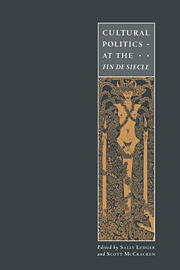Book contents
- Frontmatter
- Contents
- List of illustrations
- Notes on contributors
- Acknowledgements
- Introduction
- 1 The flight to the real
- 2 The New Woman and the crisis of Victorianism
- 3 Empire, ‘race’ and feminism at the fin de siècle: the work of George Egerton and Olive Schreiner
- 4 W. B. Yeats and Irish cultural politics in the 1890s
- 5 The double lives of man: narration and identification in late nineteenth-century representations of ec-centric masculinities
- 6 Henry James and the spectacle of loss: psychoanalytic metaphysics
- 7 ‘A very curious construction’: masculinity and the poetry of A. E. Housman and Oscar Wilde
- 8 The Pilgrims of Hope: William Morris and the dialectic of romanticism
- 9 Urban utopias: socialism, religion and the city, 1880 to 1900
- 10 Vampires and the empire: fears and fictions of the 1890s
- 11 Utopia, Limited: nationalism, empire and parody in the comic operas of Gilbert and Sullivan
- 12 Technologies of monstrosity: Bram Stoker's Dracula
- 13 Postmodernism, a Chance to reread?
- 14 Is market society the fin of history?
- Select bibliography
- Index
2 - The New Woman and the crisis of Victorianism
Published online by Cambridge University Press: 29 September 2009
- Frontmatter
- Contents
- List of illustrations
- Notes on contributors
- Acknowledgements
- Introduction
- 1 The flight to the real
- 2 The New Woman and the crisis of Victorianism
- 3 Empire, ‘race’ and feminism at the fin de siècle: the work of George Egerton and Olive Schreiner
- 4 W. B. Yeats and Irish cultural politics in the 1890s
- 5 The double lives of man: narration and identification in late nineteenth-century representations of ec-centric masculinities
- 6 Henry James and the spectacle of loss: psychoanalytic metaphysics
- 7 ‘A very curious construction’: masculinity and the poetry of A. E. Housman and Oscar Wilde
- 8 The Pilgrims of Hope: William Morris and the dialectic of romanticism
- 9 Urban utopias: socialism, religion and the city, 1880 to 1900
- 10 Vampires and the empire: fears and fictions of the 1890s
- 11 Utopia, Limited: nationalism, empire and parody in the comic operas of Gilbert and Sullivan
- 12 Technologies of monstrosity: Bram Stoker's Dracula
- 13 Postmodernism, a Chance to reread?
- 14 Is market society the fin of history?
- Select bibliography
- Index
Summary
The rise of the New Woman at the fin de siècle was symptomatic of an ongoing challenge to the monolithic ideological certainties of mid-Victorian Britain. The New Woman, the New Journalism, the New Criticism, the New Unionism: an emergent ideological epoch is clearly announced by these coinages of the 1880s and 1890s. The collision between the old and the new that characterized the fin de siècle marks it as an excitingly volatile transitional period; a time when British cultural politics were caught between two ages, the Victorian and the modern; a time fraught both with anxiety and with an exhilarating sense of possibility.
The recurrent theme of the cultural politics of the fin de siècle was instability, and gender was arguably the most destabilizing category. It is no coincidence that the New Woman materialized alongside the decadent and the dandy. Whilst the New Woman was perceived as a direct threat to classic Victorian definitions of femininity, the decadent and the dandy undermined the Victorians' valorization of a robust, muscular brand of British masculinity deemed to be crucial to the maintenance of the British Empire. The significance of the crisis in gender relations at the close of the nineteenth century has not been understated by feminist critics. Most notably perhaps, Elaine Showalter's Sexual Anarchy explores the sense of imminent anarchy within gender relations which characterized the 1880s and 1890s.
- Type
- Chapter
- Information
- Cultural Politics at the Fin de Siècle , pp. 22 - 44Publisher: Cambridge University PressPrint publication year: 1995
- 12
- Cited by



